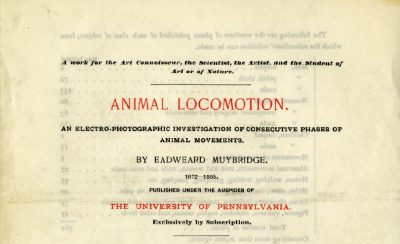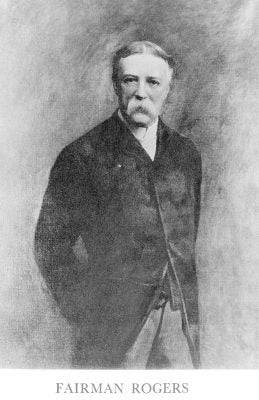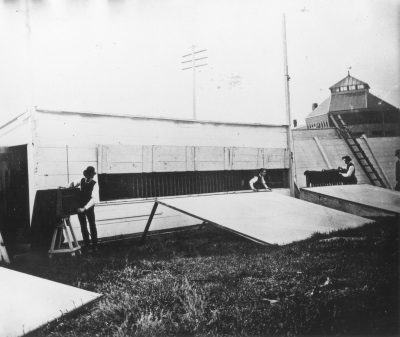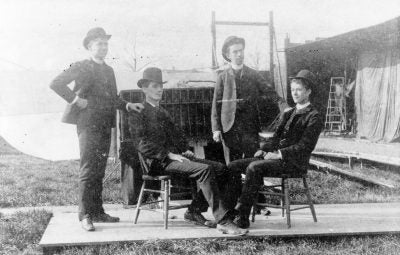Eadweard Muybridge carried out the photography for his Animal Locomotion plates on the University of Pennsylvania campus with the support of the University. This collaboration was made possible by the appeal of Muybridge’s work to the leadership and interests of the University, of Philadelphia’s art community, and of the city’s leaders in manufacture, science, and finance.
This essay provides background context for the University of Pennsylvania Archives’ Eadweard Muybridge Collection, which includes an almost complete set of the Animal Locomotion plates as well as related materials.
Origins of Muybridge's Interest in Animal Locomotion
Muybridge’s interest in animal locomotion stemmed from his work in California during the 1870s. The English-born Muybridge was known as a landscape photographer in the American West, when, in 1872 he came to the attention of Leland Stanford, head of the Union Pacific Railroad and one-time Governor of California. Stanford engaged Muybridge to photograph galloping horses to prove that, at one point during the horse’s gait, all four feet were off the ground. Muybridge’s initial photographs did not at first conclusively settle the dispute, but Stanford served as Muybridge’s benefactor through the 1870s. In 1877, after shutter technology improved exposure time from 1/500th to 1/1000th of a second, Muybridge the experiment again; this time he successfully photographed Stanford’s horse Occident to prove that a running horse indeed lifted all four feet at some point.
Muybridge’s success in this endeavor brought made him widely known. While he continued to produce panoramic landscape shots, such as a series of photographs of San Francisco taken in 1878 for Mrs. Leland Stanford, Muybridge now focused on the study of animals in motion, a new venture in the field of science and photography. In 1879 he devised a “zoopraxic” device so that his action photographs could be transformed into moving pictures projected on a screen; this invention plus Muybridge’s use of it to charge admission for viewing moving pictures in a special theater at the 1893 World’s Fair in Chicago would prompt many to identify Muybridge as the founder of the motion pictures.
Role of the University of Pennsylvania
During the early 1880s, as Muybridge traveled widely in the United State and abroad to give lectures on motion photography, he came to the attention of several prominent Philadelphians.
Philadelphia, and the University of Pennsylvania, provided the right environment for Muybridge to carry on his work. Philadelphia, with such industries as Baldwin Locomotive, was a national leader in manufacturing as well as home to a wealth of scientific institutions such as the Academy of Natural Sciences (established 1812), the Franklin Institute (1824), the Wagner Free Institute of Science (1855), and the Philadelphia Zoo (opened 1874). The Philadelphia Academy of Fine Arts was led by the realism of Thomas Eakins. And since the Civil War, the University of Pennsylvania had expanded to include the Engineering School (established 1852), the Hospital of the University of Pennsylvania (1874), the Dental School (1878), the Wharton School (1881) and the Veterinary School (1884). In Philadelphia there was appreciation of the science, technology and the art involved in Muybridge’s work – and also the financial resources to back his work.Muybridge’s connection with Philadelphia began as correspondence with Thomas Eakins, artist and professor at the Pennsylvania Academy of Fine Arts, and with Fairman Rogers, an accomplished horseman as well as a former Penn engineering professor and trustee of both Penn and the Academy. In 1883, Rogers invited Muybridge to give two lectures on his photography at the Pennsylvania Academy of Fine Arts and Philadelphia’s Academy of Music.
This led to a meeting in the office of Penn’s Provost William Pepper of a group of wealthy and influential Philadelphians (including publisher J.B. Lippincott) to discuss bringing Muybridge and his work to Philadelphia. During this meeting, the men decided to provide Muybridge with the grounds of the Veterinary Hospital and a $5,000 advance to begin work on his landmark study on animal locomotion. Penn’s trustees approved this decision and the appointing of a commission to oversee Muybridge’s work at the University; the members of this commission were:
University of Pennsylvania Faculty
- Harrison Allen, Emeritus Professor of Physiology, Secretary of the Commission
- George F. Barker, Professor of Physics
- Lewis M. Haupt, professor of Civil Engineering
- William D. Marks, Whitney Professor of Dynamical Engineering
Pennsylvania Academy of Fine Arts Faculty
- Edward A. Coates
- Thomas Eakins
Early in 1884, the University constructed an outdoor studio for Muybridge at the north east corner of 36th and Pine Streets, the present location of the Hospital of the University of Pennsylvania’s Jonathan Rhoads Pavilion on Hamilton Walk. Muybridge also had indoor space in Biological Hall, located a bit further west on Pine Street. The purchasing of photography equipment was done through the Secretary of the University, Rev. Jesse Y. Burk. After Muybridge finished his work, some of the equipment was sold by the University, but some pieces remain in the University Archives.
The outdoor studio consisted of a three-sided black shed and three batteries of cameras to photograph the subject from the side, the front or back, and from a 45 degree angle. Exposures were made by having electromagnets that released the shutters in sequence and at equal intervals. White strings hung on the back wall of the shed to form a grid to measure the movement of a human or animal as it passed through the frames.
During the time he worked on this project, Muybridge improved his photographic techniques by using dry plate technology, rather than the wet plate technology he had previously used. He also came to equip his three batteries of twelve cameras each with electronically released shutters, allowing shorter exposure times which were not triggered by subjects’ movements.
Below is a photograph of one of the three batteries of cameras used by Muybridge to produce the Animal Locomotion images; above the camera is the plate holder for these cameras (note that this camera is not included in the holdings of the University Archives). The design of this custom-made, unique equipment was based on what Muybridge had learned from his earlier experiments with several race track cameras in a row. This camera has thirteen lenses. The one on the far left was for focusing; the other twelve lens took the pictures. The shutter for each lens opened one at a time, as controlled by the complicated electronic mechanism.
Members of the commission overseeing Muybridge’s work at Penn included Thomas Eakins as well as professors from Penn’s Medical, Veterinary and Engineering Schools. Such Penn faculty members as William D. Marks, professor of engineering, and Edward Reichert, professor of physiology, worked with Muybridge.
Muybridge did not have to look far for models. The nearby Zoo provided the animals; the Philadelphia Almshouse next to Penn’s campus provided the disabled models; and many of the male models came from the University community. As explained in an 1886 article in Penn’s student newspaper, Muybridge photographed students and faculty from the University of Pennsylvania:
The part most interesting to [University of] Pennsylvania men is the delineation of the athletic sports, foot-ball and base-ball, running, jumping, vaulting and wrestling. Nearly every well-known University athlete of the past two or three years has served as a model in the nude, many of them showing magnificent physiques, and exhibiting exquisitely the play of every muscle. The facial expressions in successive intervals of some feat of skill and strength, is a study in itself…
….’See how curiously,’ said Mr. Muybridge, referring to a photographic series (Plate 288 shown above) of one of our most prominent University baseball nine, ‘and yet how perfectly, this plate illustrates the occurrence of an error in catching.’ True enough. In the successive pictures the ball is muffed, strikes the player’s thigh, runs up under his arm and across his back, while he is looking eagerly on the wrong side for it.
Muybridge models affiliated with Penn included faculty member Dr. Rush S. Huidekoper, and student athletes George Brinton, Robert Edward Glendinning, Frank Bird Gummey, Thomas Love Latta, and Morris Hacker, Jr.







